Plaid Backgrounds
by Beverly Stewart
Make your own plaid backgrounds.
Supplies

- Cardstock (Watercolor paper and Dapper Denim used here, white cardstock for practicing)
- Variety of markers and pens (Chisel Point Highlighters, Sharpie, and Gel Pens used here)
- Aquapainter or other watercolor brush
- Watercolor medium (ink from Real Red, Crushed Curry, and Dapper Denim ink pads used here)
- Masking tape or washi tape
- Ruler or straight edge
- Scoring tool or ruler and pencil
- Black StazOn Pad (optional)
- Other supplies as needed to complete the project
Step-by-Step
-
Step 1
Use your favorite internet search engine to research plaids and to open your eyes to the multitude of options. Search for “Plaid Patterns” or “Tartan Patterns”. Click on “Images” to see only the plaids. Narrow the results by clicking on a color or the specific name of a plaid.
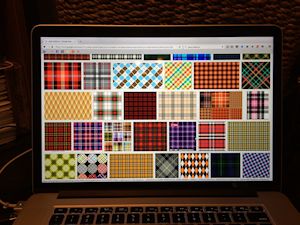
-
Step 2
Begin by practicing with a piece of white cardstock. You can use a full sheet or cut it into card front sizes. This is practice, but use cardstock in case you like the results and want to use it on a card. Give yourself permission to experiment, make mistakes and throw it away if you don’t like it.
Use markers and pens you are familiar with, so you are only worried about the pattern to begin with and not the tools.
-
Step 3
Practice drawing with chisel point markers or highlighters. Begin with a simple check or gingham. These are evenly spaced lines using a single color—about a marker’s width apart in both directions.

-
Turn your paper to get the steadiest position for your hand. Keep your work right in front of you and you will draw straighter lines.

-
Step 4
Embellish some of your gingham practice pieces with thinner lines. Try going right across the middle of the lines you have already drawn…

-
…or across the white spaces.
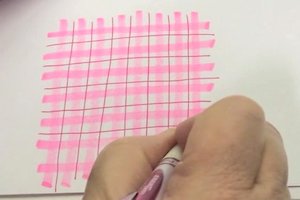
-
Step 5
For a more complex plaid, draw a widely spaced gingham with very wide lines and very wide white spaces between them—try about 3/8" or 1/2" lines and spaces.
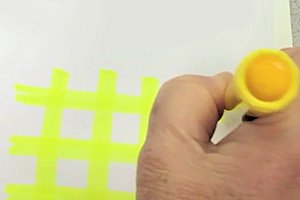
-
Change marker colors and draw a marker’s width (1/4”) line down the middle of the white spaces.
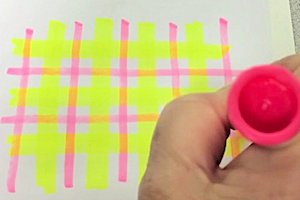
-
Step 6
Draw a double row of lines down the middle of your original wide (yellow) line.
Variations for practice:
Single line down middle of white space. Single or double line down the center of a broad stripe. Single or double lines next to a broad stripe, but off center. Varying widths and colors. If you want to keep the practice pieces you have worked on, you can die cut them into shapes to use on your cards.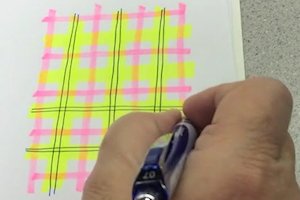
-
Step 7
Prepare a grid to help guide your hand and eye. Use a gridded mat or paper, or create your own. One way is to create scored grid lines on cardstock.
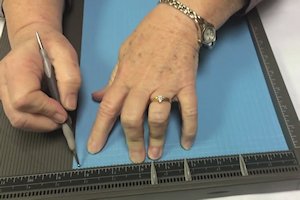
-
Turn the scored paper over and run a black StazOn pad over the lines on the back to emphasize the grid.
NOTE:
StazOn is waterproof so you won’t get smudges on your finished piece.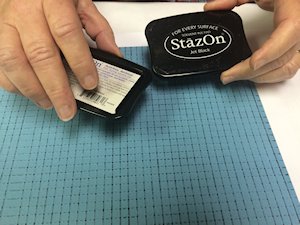
-
Step 8
Align and tape a card front to the grid with masking tape. You may use a ruler or a straight edge as a guide to line up the grid marks and show your brush where to go.
TIP:
If using a ruler as a guide line, don’t put the brush right next to the ruler. Water will flow under your ruler and make a mess. Put the ruler near the brush and let your eye follow the ruler, but don’t let the brush touch it.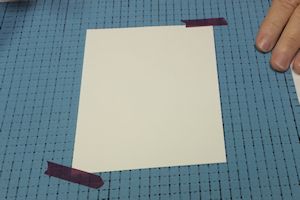
-
Step 9
Create straight lines from one side of the card front to the other. Start with the short side to gain confidence.
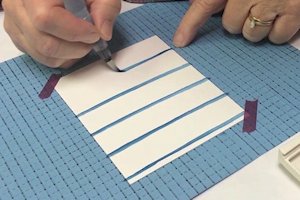
-
Continue adding colored lines in one direction. To avoid color bleeding, it is important to allow the stripes to dry completely before adding criss-cross stripes.
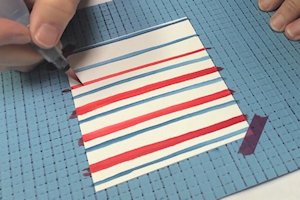
-
Step 10
Turn the panel and repeat the pattern.

-
Step 11
Use the finished panel to create a card or other project.
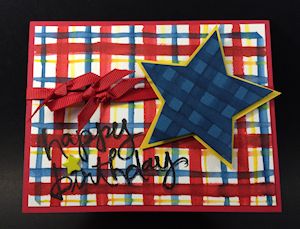
Video!
Variations
-
Try working on colored cardstock. This works especially well with tone on tone colors and/or white on colored cardstock.
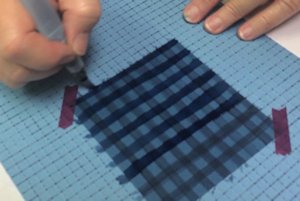
-
Angle the cardstock on the grid and create a diagonal plaid using the same process.
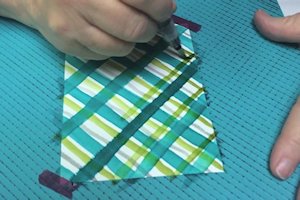
Your Turn
You've seen the tutorial, now you try it! We've got a section of the gallery set aside for Plaid Backgrounds. Try this technique, then upload your artwork to the gallery. Show us your creations!
***Please note - Internet Explorer/Edge is not a supported browser, and will not allow you to see the videos. Please use Chrome, Firefox or Safari to view our tutorial videos.

Questions and Comments
We'd love to get your feedback or questions. Leave your comment below.
Page 1 of 1 pages